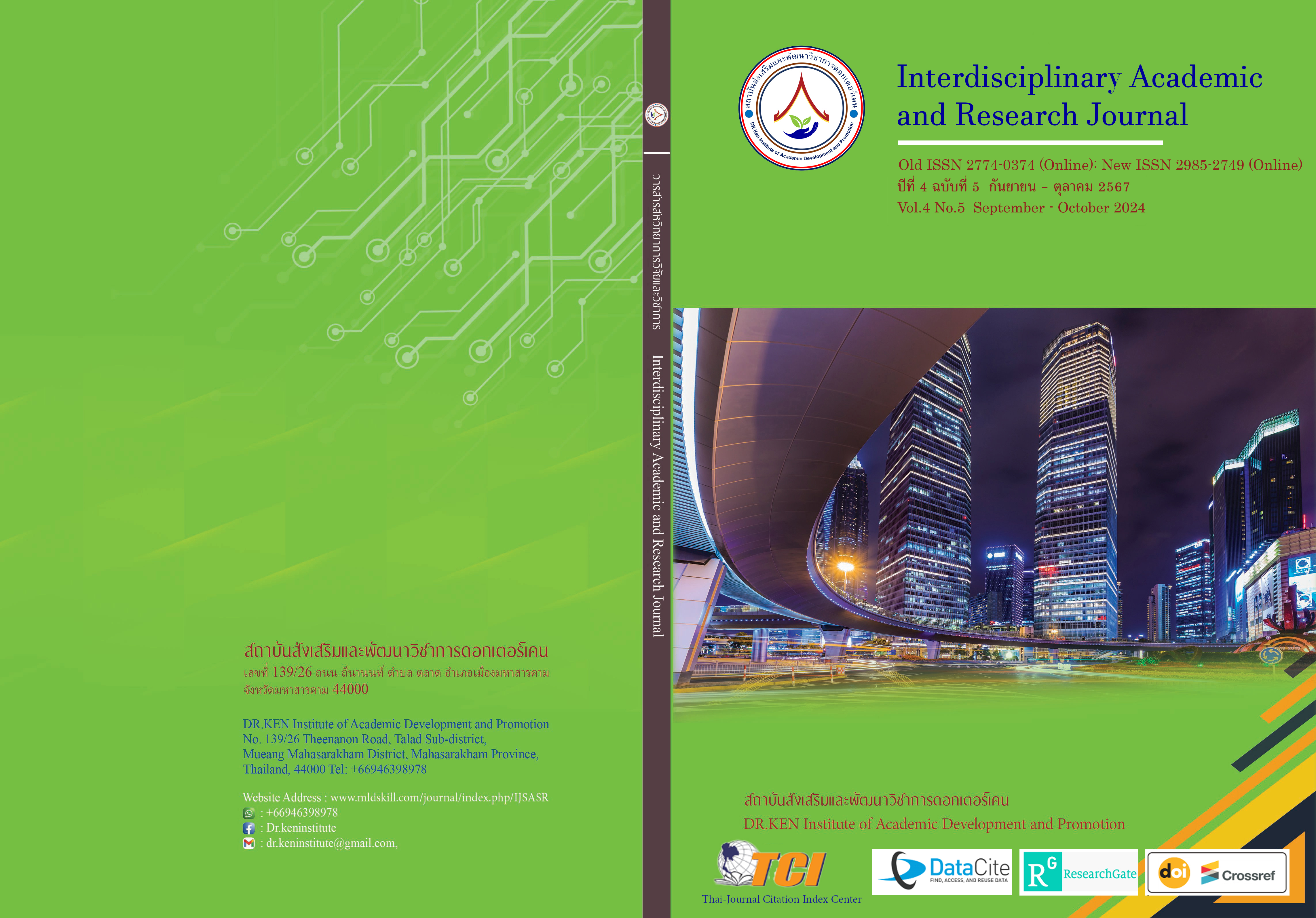Applying the "Sweet-Talking Community Checkpoint (Positive Communication Community Checkpoint)" Strategy to Promote Helmet Use in Sisaket Province: Lessons Learned and Policy Recommendations
DOI:
https://doi.org/10.60027/iarj.2024.277424Keywords:
Sweet-Talking Community Checkpoint, , Helmet Use, , Community Participation, , Road Safety,, Sisaket ProvinceAbstract
Background and Aims: The helmet-wearing rate among motorcycle riders in Sisaket province was low, especially among passengers. This study aimed to 1) analyze the success factors, challenges, and lessons learned from the implementation of the "Sweet-Talking Community Checkpoint" strategy in the area through the collection and synthesis of relevant documents and field observations, 2) evaluate the effect of the "Sweet-Talking Community Checkpoint" strategy on promoting helmet use among motorcycle riders in Sisaket province by considering the helmet-wearing rates of drivers and passengers in each district, and 3) propose policy recommendations for scaling up and improving the effectiveness and sustainability of the "Sweet-Talking Community Checkpoint" strategy, as well as its application in promoting other road safety behaviors.
Methodology: This study employed qualitative research methods. Data were collected from relevant documents, including performance reports, and guidelines, and through participatory observations during field visits to support the implementation of community checkpoints. The obtained data were analyzed using content analysis to summarize key issues.
Results: The study found that the helmet-wearing rate among motorcycle riders in Sisaket province remained low, particularly among passengers (36.6% for drivers and 21.5% for passengers), with significant differences between districts. Key factors contributing to the success of the "Sweet-Talking Community Checkpoint" measures included community participation, diverse communication strategies, the establishment of leaders and volunteer networks, and continuous reinforcement by the Governor of Sisaket province and his team. However, there were challenges in maintaining long-term motivation, changing traditional values, and ensuring the continuity of campaign activities.
Conclusion: The "Sweet-Talking Community Checkpoint" strategy was an effective tool for promoting helmet use in the area. The implementation should be expanded and extended in the long term, focusing on promoting community participation, using diverse communication strategies, and establishing a mechanism for continuous reinforcement. Additionally, special attention should be given to the passenger group, and the strategy should be expanded to address other risk behaviors related to road safety.
References
กรมควบคุมโรค กระทรวงสาธารณสุข. (2562). แผนปฏิบัติการป้องกันและลดอุบัติเหตุทางถนน ปี พ.ศ. 2563-2565. นนทบุรี: สำนักโรคไม่ติดต่อ กรมควบคุมโรค กระทรวงสาธารณสุข.
มูลนิธิไทยโรดส์. (2563). รายงานสถานการณ์อุบัติเหตุทางถนนของประเทศไทย ปี 2562. กรุงเทพฯ: มูลนิธิไทยโรดส์.
ศูนย์อำนวยการความปลอดภัยทางถนนจังหวัดศรีสะเกษ, (2567). จังหวัดศรีสะเกษ ประชุมถอดบทเรียนการดำเนินงานป้องกันและลดอุบัติเหตุทางถนนช่วงเทศกาลสงกรานต์ 2567 เพื่อหาแนวทางลดการสูญเสียในครั้งต่อไป. Retrieved from: https://thainews.prd.go.th/thainews/news/view/289811/?bid=1
สำนักงานกองทุนสนับสนุนการสร้างเสริมสุขภาพ. (2563). การสำรวจพฤติกรรมเสี่ยงโรคไม่ติดต่อและการบาดเจ็บ พ.ศ. 2562. กรุงเทพฯ: สำนักงานกองทุนสนับสนุนการสร้างเสริมสุขภาพ.
Fong, M.C., Measelle, J.R., Dwyer, J.L., Taylor, Y.K., Mobasser, A., Strong, T.M., & Maitoza, R. (2015). Rates of motorcycle helmet use and reasons for non-use among adults and children in Luang Prabang, Lao People's Democratic Republic. BMC Public Health, 15(1), 970.
Gupta, M., Menon, G.R., Devkar, G., & Thomson, H. (2015). Regulatory and road engineering interventions for preventing road traffic injuries and fatalities among vulnerable road users in low-and middle-income countries: a systematic review. Systematic Reviews, 4(1), 1-10.
Haqverdi, M.Q., Seyedabrishami, S., & Groeger, J.A. (2015). Identifying psychological and socio-economic factors affecting motorcycle helmet use. Accident Analysis & Prevention, 85, 102-110.
Lajunen, T., & Räsänen, M. (2004). Can social psychological models be used to promote bicycle helmet use among teenagers? A comparison of the Health Belief Model, Theory of Planned Behavior, and the Locus of Control. Journal of Safety Research, 35(1), 115-123.
Papadakaki, M., Tzamalouka, G., Orsi, C., Kritikos, A., Morandi, A., Gnardellis, C., & Chliaoutakis, J. (2013). Barriers and facilitators of helmet use in a Greek sample of motorcycle riders: Which evidence? Transportation Research Part F: Traffic Psychology and Behaviour, 18, 189-198.
Passmore, J.W., Nguyen, L.H., Nguyen, N.P., & Olivé, J.M. (2010). The formulation and implementation of a national helmet law: a case study from Viet Nam. Bulletin of the World Health Organization, 88, 783-787.
Ratanavaraha, V., & Jomnonkwao, S. (2013). Community participation and behavioral changes to enhance road safety in Thailand. Transport Policy, 25, 111-118.
Sasser, S., Varghese, M., Kellermann, A., & Lormand, J.D. (2005). Prehospital trauma care systems. Geneva: World Health Organization.
Sood, N., Bendavid, E., Mukherji, A., Wagner, Z., Nagpal, S., & Mullen, P. (2014). Government health insurance for people below the poverty line in India: quasi-experimental evaluation of insurance and health outcomes. BMJ-BRITISH MEDICAL JOURNAL, 349. DOI 10.1136/bmj.g5114
World Health Organization. (2018). Global status report on road safety 2018. World Health Organization. https://apps.who.int/iris/handle/10665/276462
Xuequn, Y., Ke, L., Ivers, R., Du, W., & Senserrick, T. (2011). Prevalence rates of helmet use among motorcycle riders in a developed region in China. Accident Analysis & Prevention, 43(1), 214-219.
Downloads
Published
How to Cite
Issue
Section
License
Copyright (c) 2024 Interdisciplinary Academic and Research Journal

This work is licensed under a Creative Commons Attribution-NonCommercial-NoDerivatives 4.0 International License.
Copyright on any article in the Interdisciplinary Academic and Research Journal is retained by the author(s) under the under the Creative Commons Attribution-NonCommercial-NoDerivatives 4.0 International License. Permission to use text, content, images, etc. of publication. Any user to read, download, copy, distribute, print, search, or link to the full texts of articles, crawl them for indexing, pass them as data to software, or use them for any other lawful purpose. But do not use it for commercial use or with the intent to benefit any business.
















.png)


